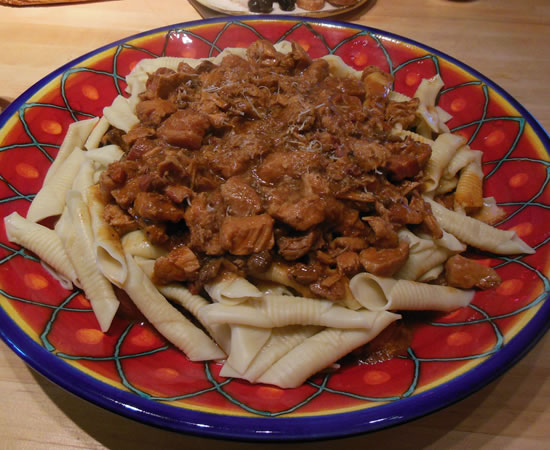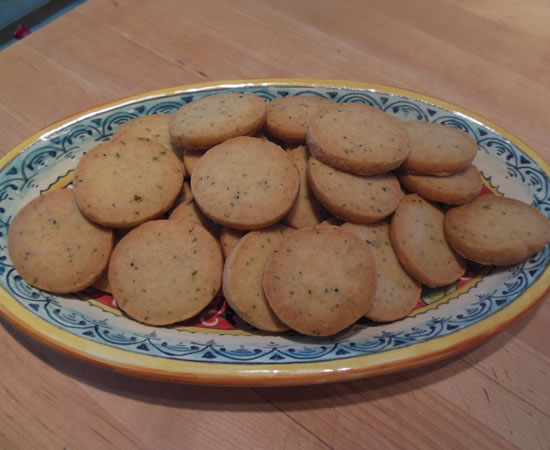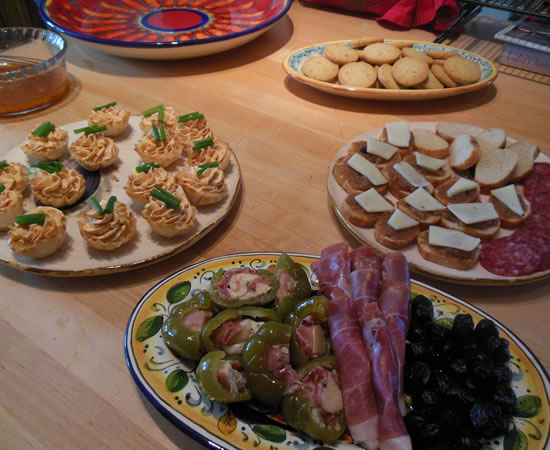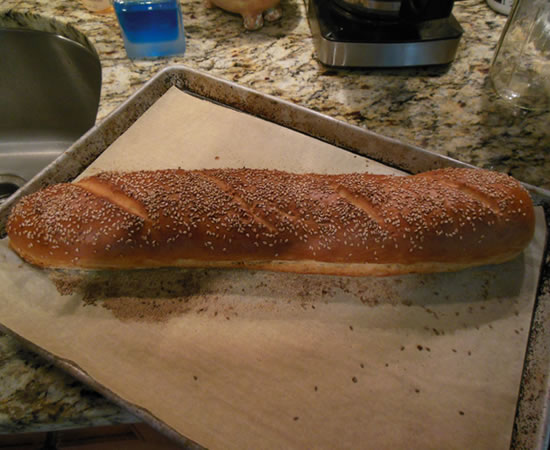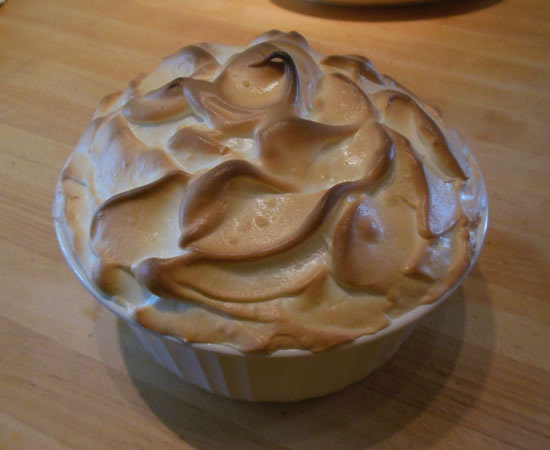Our biannual dinner with Linda and David was a rousing success!
It’s fun kinda going over the top now and again – and not easy cooking for a mere four people! My instincts are to make massive amounts of food for massive amounts of people. This turns into massive amounts of food for a mere four people.
We decided early on that we were going to do a strictly-Italian dinner because, well… we had to show off our fabulous hand-painted Italian dinnerware we had made for us on our recent trip to Italy. Yes. It is fun being insufferable now and again…
We also decided we would do a hand-made pasta because Victor has the pasta-making down to a science. He just flat-out makes fabulous pasta.
The sauce was to be a pheasant recipe from Lidia we made many times back in California when our next door neighbor would show up on our doorstep with pheasants he had just shot.
Damn, they were good.
Alas, it’s not as easy to find pheasant here in suburbia. I actually ordered one from the local Wegmans and when I went to pick it up on Wednesday, it was really small and really expensive. I would have needed at least two of them for dinner and I just couldn’t justify spending $30.00 each for them. They were very nice when I said “no thanks.”
I came home empty-handed and Victor suggested pork. Brilliant, as we not only had cubed pork in the freezer, we also had a chunk of wild boar ventrèche. Ventrèche is marbled pork belly with a firm texture, similar to pancetta. It’s rich, salty and very porky – the perfect addition to a dish that should have a bit of a gamy edge to it. Crisis averted and a new dish was born.
I made the sauce yesterday because it is definitely the type of dish that improves with an overnight stay in the ‘fridge.
Garganelli con Maiale in Guazetto
- ½ cup dried porcini mushrooms
- 4 whole cloves
- 2 bay leaves
- 1 sprig fresh rosemary
- ¼ cup extra-virgin olive oil
- 2 1/2 lbs cubed pork
- freshly ground black pepper
- ½ cup chicken liver, trimmed and finely chopped
- 3 medium onions, chopped
- 8 oz ventrèche, thick-sliced
- 1 cup dry white wine
- 3 tablespoons tomato paste, plus 2 teaspoons
- 4 cups beef broth
- ½ cup Parmigiano-Reggiano, freshly grated, plus more for serving
Garganelli, made from basic egg pasta dough
Soak the porcini in 2 cups of warm water until softened, about 30 minutes. Drain the porcini, reserving the liquid. Rinse the mushrooms and chop them coarsely, discarding any tough bits. Strain the soaking liquid through a sieve lined with cheesecloth. Set the liquid and chopped mushrooms aside. Tie the cloves, bay leaves, and rosemary securely in a small square of cheesecloth.
In a large casserole heat the oil over high heat. Add the pork pieces and sprinkle lightly with salt and pepper. Cook until lightly browned, about 10 minutes. Remove the pork pieces.
Add the onions to the casserole, season them lightly with salt and pepper and cook until golden, about 5 minutes. Add the chicken livers and cook them, turning as necessary, until browned, about 4 minutes. Add the chopped porcini and cook, stirring, until they are dry, about 5 minutes. Add the wine and cook, stirring, until nearly evaporated, about 4 minutes. Stir in the tomato paste until the vegetables are coated. Add the reserved porcini liquid and about 1/2 cup of the beef broth and bring to a boil. Return the pork pieces to the pan and tuck the cheesecloth packet into the liquid. Cover the casserole partially and simmer gently until the liquid is reduced by about half, about 15 minutes. Continue simmering, adding beef broth 1/2 cup at a time and waiting until the liquid is reduced by half before adding more, until the pork is tender and the liquid is velvety, about 1 hour. Remove and discard the cheesecloth packet. Remove the meat and shred it coarsely. Return it to the sauce and reheat before serving.
And while I was at work, yesterday, Victor made the pasta.
Every one of those little buggers was cut and rolled by hand. This is where Victor excels over me. I do not have nearly the patience necessary to make this. The pasta is hand-made and rolled, then cut into squares, rolled around a little stick – Victor used a chop stick – and then rolled down a grooved board.
Each one.
Individually.
His pasta is excellent. Every time. I see no need to even try at this point.
Garganelli
- 3 cups “00” Italian flour – or all-purpose flour
- 4 large eggs
- ½ teaspoon salt
- 1 teaspoon extra-virgin olive oil
- warm water as needed
Place 3 cups of flour in a mound on a wooden surface, Make a well in the center of the mound. Beat the eggs, olive oil and salt together in a small bowl. Pour them into the well. With your finger, slowly incorporate the flour into the eggs until it is mixed.
Knead the remaining flour into the dough until a rough and slightly sticky dough is formed.
Knead the dough by gathering it into a compact ball, then pushing the ball away from you with the heels of your hands. Repeat the gathering and pushing motion several times, then press into the dough, first with the knuckles of one hand, then with the other, several times. Alternate between kneading and ‘knuckling’ the dough until it is smooth, silky and elastic-it pulls back into shape when you stretch it. The process will take about 10 minutes of constant kneading. Flour the work surface and your hands lightly any time the dough begins to stick while you’re kneading.
Roll the dough into a smooth ball and place in a small bowl. Cover with plastic wrap. Let the dough rest at least one hour at room temperature, or up to 1 day in the refrigerator before rolling and shaping the pasta. If the dough has been refrigerated, let it stand at room temperature for about an hour before rolling and shaping.
To shape garganelli:
Run pasta through a pasta roller to about the second-thinnest setting. Cut into squares about 1-1 1/2″. moisten one corner with a bit of water or egg and, from the opposite corner, roll around a wooden spoon handle or chopstick. Roll pasta down a grooved gnocchi board, pressing to create ridges and seal each piece of pasta.
Cook in boiling salted water about 6 minutes.
We had to start off with a few appetizers, of course. My first thought was to have an all-Italian cheese plate with some breads and crackers. Then I decided to make some crackers. Ina Garten has a great recipe for a cheese and thyme cracker – so off I went.
Parmesan Thyme Crackers
adapted from Ina Garten
- 1 cube unsalted butter, at room temperature
- 4 ounces freshly grated Parmesan cheese (about 1 cup)
- 1 teaspoon minced fresh thyme leaves
- 1/2 teaspoon kosher salt
- 1/2 teaspoon freshly ground black pepper
- 1 1/4 cups all-purpose flour
Cream the butter in mixer fitted with paddle attachment for 1 minute. Slowly add the Parmesan, thyme, salt, and pepper and mix well. With the mixer still on low, add the flour and combine until the mixture is in large crumbles, about 1 minute. If the dough is too dry, add 1 teaspoon water.
Dump the dough onto a floured board, press it into a ball, and roll into a 9-inch log. Wrap in plastic and refrigerate for at least 30 minutes or for up to 4 days.
Meanwhile, preheat the oven to 350°. Cut the log into 3/8-inch-thick rounds with a small, sharp knife and place them on a sheet pan lined with parchment paper. Bake for 22 minutes, until very lightly browned. Cool and serve at room temperature.
The crackers came out so good I decided adding cheese with them was overkill.
And then there was fig and onion on baguette with Italian truffle cheese, roasted red pepper cream cheese in filo cups, hot pepper shooters, prosciutto, salami, oil-cured olives, and a hot hors d’oeuvre made with thinly-rolled bread dough topped with salami, sauteed fennel, and gorgonzola cheese, and then topped with another thin sheet of dough and baked at 400° for about 15 minutes. Alas, I didn’t get a picture of it.
Fresh-baked bread, of course. I made a batch of James Beard’s Continental Bread.
James Beard French-Style Bread
- 1 package active dry yeast
- 2 tsp sugar
- 2 cups warm water (100° to 115°, approximately)
- 2 tsp salt
- 5 cups bread flour
- 3 tablespoons yellow cornmeal
- 1 egg white, mixed with 1 tablespoon cold water
- sesame seeds
Directions
Combine the yeast with sugar and warm water in a large bowl and allow to proof. Mix the salt with the flour and add to the yeast mixture, a cup at a time, until you have a stiff dough. Remove to a lightly floured board and knead until no longer sticky, about 10 minutes, adding flour as necessary. Place in a buttered bowl and turn to coat the surface with butter. Cover and let rise in a warm place until doubled in bulk, 1½ to 2 hours.
Punch down the dough. Turn out on a floured board and shape into long, French bread-style loaves. Place on a baking sheet that has been sprinkled with the cornmeal but not buttered. Slash the tops of the loaves diagonally in two or three places, and brush with the egg wash and sprinkle with sesame seeds. Place in a cold oven, set the temperature at 400°, and bake 35 minutes, or until well browned and hollow sounding when the top is rapped.
I actually just made one loaf and used the rest of the dough for the appetizer.
And then we had dessert…
Zuppa Inglese. It translates to “English Soup.” We first had it at a great restaurant in Florence. I’ve now made it twice and this time was the best. I think I finally have it down.
Zuppa Inglese
Sponge cake:
- 2 tbsp unsalted butter, melted
- 1 cup sifted cake flour
- 1/2 cup sugar
- 1/8 tsp salt
- 4 large eggs, at room temperature
- 1 tsp pure vanilla extract
Pour the melted butter into a 1-quart bowl; reserve. Return the sifted flour to the sifter or sieve and add 1 tbsp of the sugar and the salt; sift onto a piece of waxed paper and set aside.
Put the eggs and the remaining sugar into the bowl of a heavy-duty mixer (or work with a hand-held mixer). Holding the whisk attachment from the mixer in your hand, beat the mixture to blend the ingredients. With the bowl and whisk attachment in place, whip the mixture on medium speed until it is airy, pale, and tripled in volume, like softly whipped cream, 4 to 5 minutes. You’ll know that the eggs are properly whipped when you lift the whisk and the mixture falls back into the bowl in a ribbon that rests on the surface for about 10 seconds. If the ribbon immediately sinks into the mixture, continue whipping for a few more minutes. Pour in the vanilla extract during the last moments of whipping.
Detach the bowl from the mixer. Sprinkle about one third of the sifted flour mixture over the batter. Fold in the flour with a rubber spatula, stopping as soon as the flour is incorporated. Fold in the rest of the flour in 2 more additions.
Gently spoon about 1 cup of the batter into the bowl with the melted butter and fold the butter in with the rubber spatula. Fold this mixture into the batter in the mixer bowl. (This is the point at which the batter is at its most fragile, so fold gingerly.) The batter should be poured into a prepared pan and baked immediately.
Bake at 350° about 25-27 minutes or until cake springs back when lightly touched and just begins to pull away from the sides of the pan.
Cool in pan about 10 minutes then remove, cooling right-side up on cooling rack.
Sugar Syrup:
- 1 cup sugar
- 1 cup water
- 2 tbsp limoncello
Mix ingredients. Bring to boil in small saucepan and boil about 1 minute. Cool and set aside.
Pastry Cream
- 2 cups whole milk
- Grated zest of 1 lemon
- 1 egg
- 2 egg yolks
- ⅓ cup sugar
- ⅓ cup unbleached all-purpose flour
- 1 teaspoon vanilla extract
Bring the milk and lemon zest to just below the boiling point; remove from the heat. In a medium bowl, beat the egg, egg yolks, and sugar until creamy. Add the flour and vanilla as you beat with a whisk, then slowly beat in the hot milk, still whisking. Pour the mixture into the pot in which you heated the milk. Cook over medium heat, stirring, until thick, about 5 minutes. Transfer to a bowl, cover, and refrigerate 2 hours.
Meringue
- 4 egg whites
- 1/2 cup sugar
Whip egg whites. Slowly add sugar and continue whipping until firm peaks are formed.
To assemble
Slice cake horizontally into three layers. Cut to snugly fit bottom of baking dish. Liberally douse with sugar syrup. Cover with half the pastry cream. Place second layer of cake on top, press down, again liberally douse with sugar syrup and the rest of the pastry cream. Top with final layer of cake.
Completely seal top of dish with meringue. Place in 450° oven about 5 minutes to brown meringue.
Serve at room temperature.
It’s just spooned out onto the plate. It doesn’t necessarily make the most fabulous presentation, but no one notices after the first bite!
A fun meal with fun friends. The perfect way to end the year.

